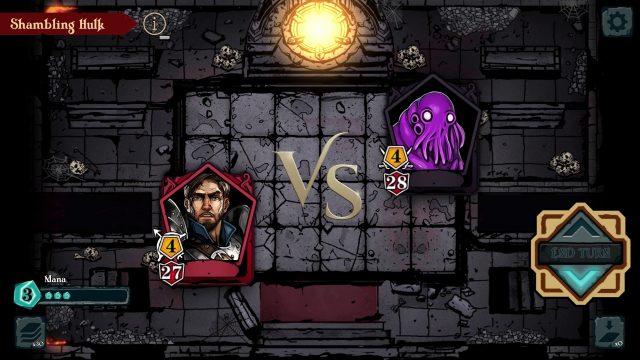Smooth gameplay; high replay value
A few bugs that made me restart; base difficulty may be too hard for some players
Exploring dungeons is one of the oldest RPG gaming elements, with Dungeons and Dragons having been published back in 1974, yet it remains an enjoyable experience in 2020. In DungeonTop: Spell Sword Cards, players will explore deeper floors all while collecting new cards, treasure, and defeating various enemies. The experience takes about 90 minutes assuming you survive long enough to escape.
As a roguelike deck building game, DungeonTop will feel similar for those who have played Slay the Spire or Gwent from Witcher 3. According to the developers, “we wanted to make a chess-like game but without all the boring bits.” Combat does feel like chess, but instead of moving pieces, you play cards from your hand. Most cards cost one mana point to place on the board and you usually only have 3 mana points per turn so choose which cards to play wisely. There are three card types. Minion cards are units that fight in battle, spells are cards with various abilities that are used immediately when played, and consumable items are cards that are used immediately then exhausted from play. Each minion card can move across the board and has its own power, HP, and ability.
The combat itself takes place on a grid board and minions move across each tile. Most minions will not be active until the next turn; therefore, the game requires you to think in advance. There are various strategies you can employ that depend on the cards you draw from your deck and which abilities minions have. A minion can have ranged attack, tank more hits, rush enemies by moving immediately, or flank enemies by leaping across the board. Unlike strategy games like Fire Emblem, minions will frequently be destroyed in combat since the objective is to destroy the “king” on the board. Don’t worry, minion and ability cards destroyed are returned at the end of a match unless they were a consumable item.
After defeating each enemy, you will have the option to add two new cards to your deck; three if the enemy is a boss. The options include new minions, weapons for your hero to equip, consumable items, spells, and treasure. There are over 800 different cards to unlock and how your deck evolves throughout your playthrough will affect the tactics you use in combat. Cards can also be gained from shops and upgraded at blacksmiths. Each floor has one of each and each will offer you one free card and one free upgrade. After that, you will need to trade a treasure card.
Sacrificing treasure for upgrades and cards is an example of how the game balances risk and reward. Treasure cards aren’t useless but in fact are strong playable cards in battle. You must decide if they are worth sacrificing for an enticing new card in a shop or to upgrade a spell at a blacksmith. Another way the game makes you make take risks is deciding how many treasure cards to sacrifice at the end of each floor. Treasure cards can be sacrificed for treasure at the end of each floor. Treasure is a desirable asset when starting a new game as it allows you to unlock new cards.
Along with building your deck, your hero will also gain experience points. With each level up you will have the option to choose a new talent such as an HP boost or having an extra card in your hand each turn. Some of these talents I found extremely helpful. But don’t get too attached to your deck or talents! Death will likely be common and happen fairly quickly when you first start playing and everything resets at game over.
At the start of each new game you have hero classes and allegiances to choose from. The class you pick will determine what spells cards you have access to in a game. Your allegiance affects which minion cards you have. Only the warrior class is available at the start with mage and rogue being unlockable. Treasure gained from previous playthroughs can be used to unlock both new classes and unlock new cards to find while in the dungeon.
The combination of cards, talents, class, and allegiance gives this game significant replay value. Each playthrough will feel different and even game over screens lead to progress. With each try you will bring back more treasure used to unlock new cards. The lack of a compelling narrative does nothing to hurt the replay value as it is the gameplay that will keep you coming back.
Though there isn’t much in the story department, great visuals in DungeonTop make it easy to ascribe personality and other traits to the heroes and monsters. In deck building games, it’s fun to collect appealing or interesting looking cards and DungeonTop does not disappoint. Visually, the game takes inspiration from Darkest Dungeon, but less dark and saturnine.
Unfortunately, not even the best visuals will distract from the bugs. A few bugs during matches caused the buttons to stop working which lead me to close and restart the game. It wasn’t a big deal since I was still on the first floor, but if it had occurred when I was deeper in the dungeon, I would have been pretty annoyed.
Fans of strategy and deck building games are likely to enjoy DungeonTop. Its appealing visuals and huge customization potential gives it a lot of replay value. However, replay may happen sooner than you think due to the game’s base difficulty or bugs that force you to restart.
Nintendojo was provided a copy of this game for review by a third party, though that does not affect our recommendation. For every review, Nintendojo uses a standard criteria.




 ShareThis
ShareThis








